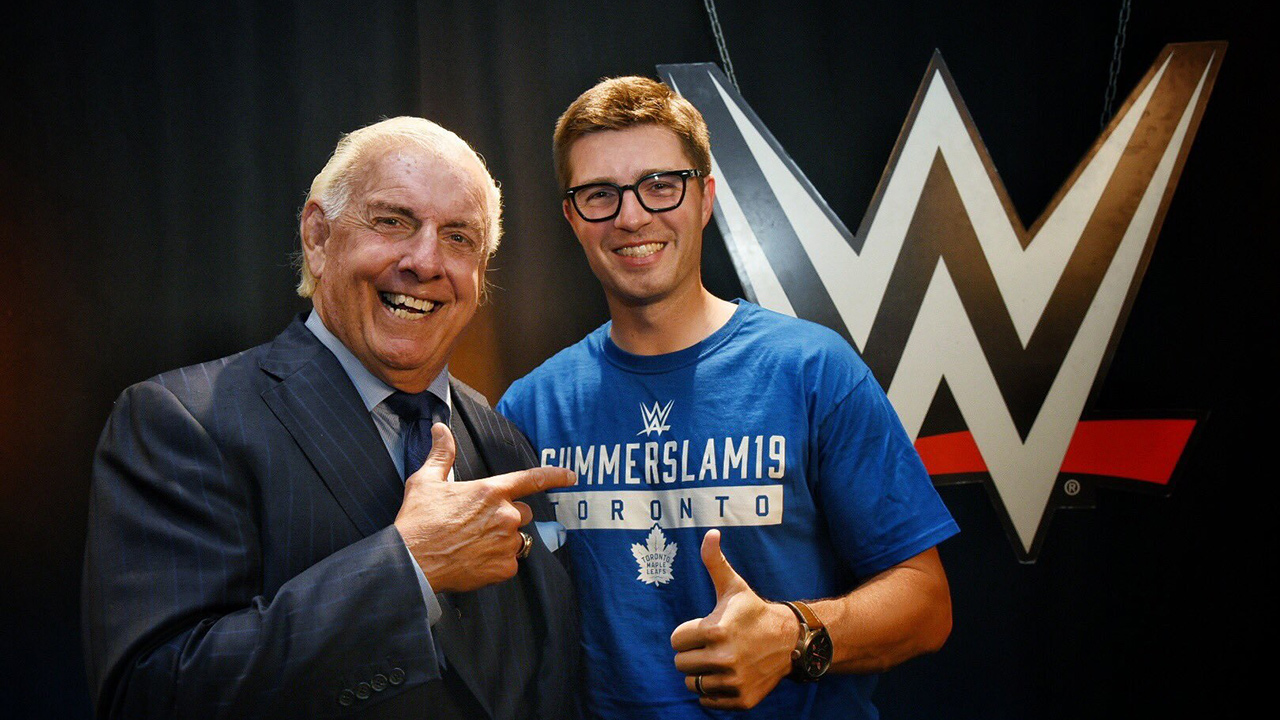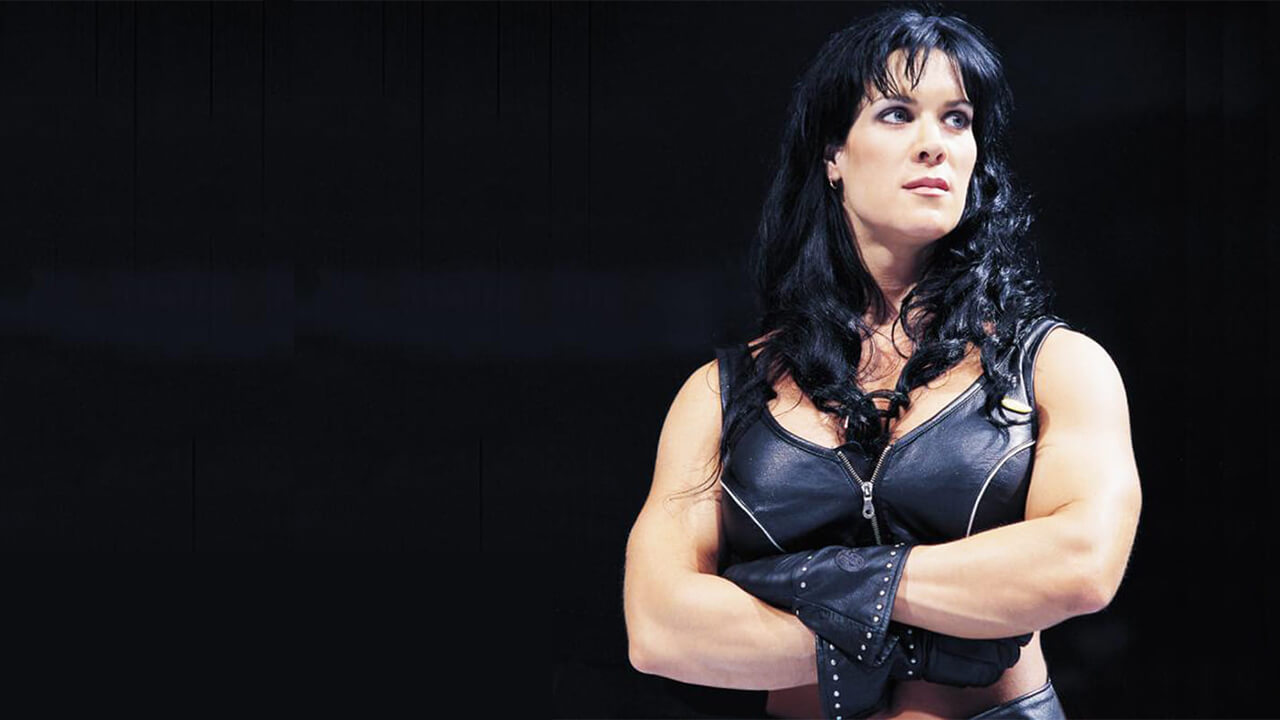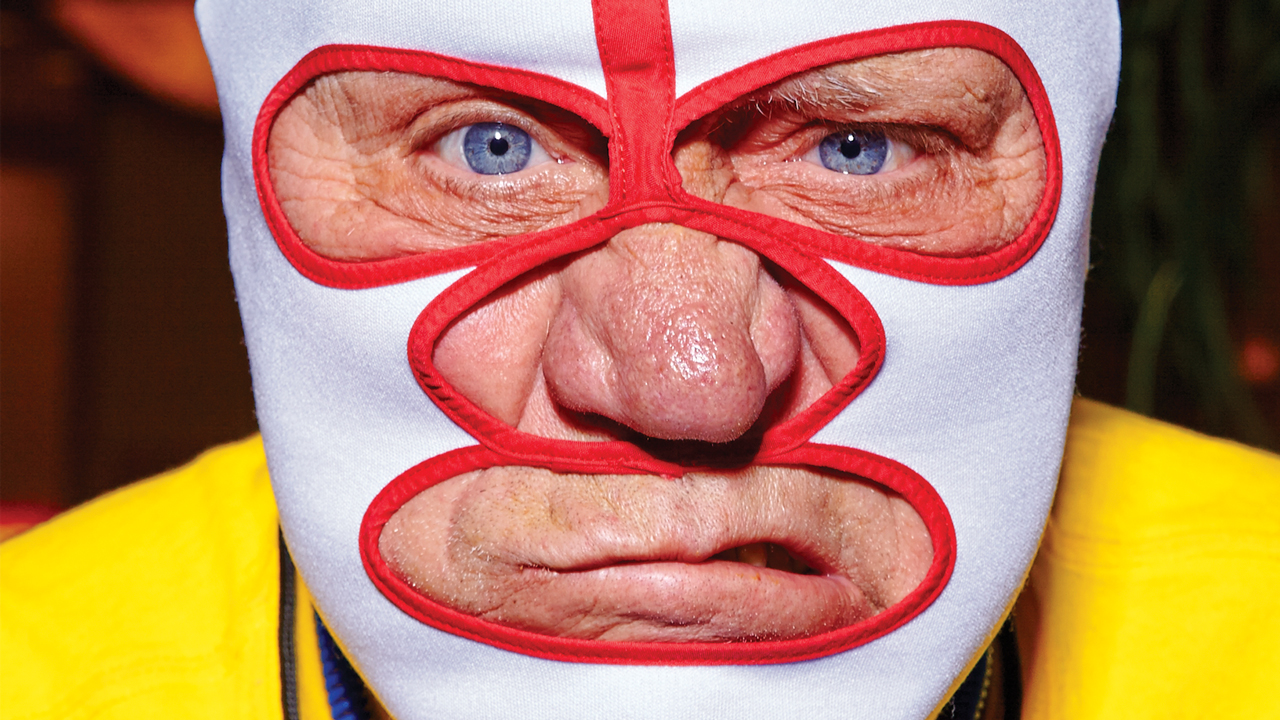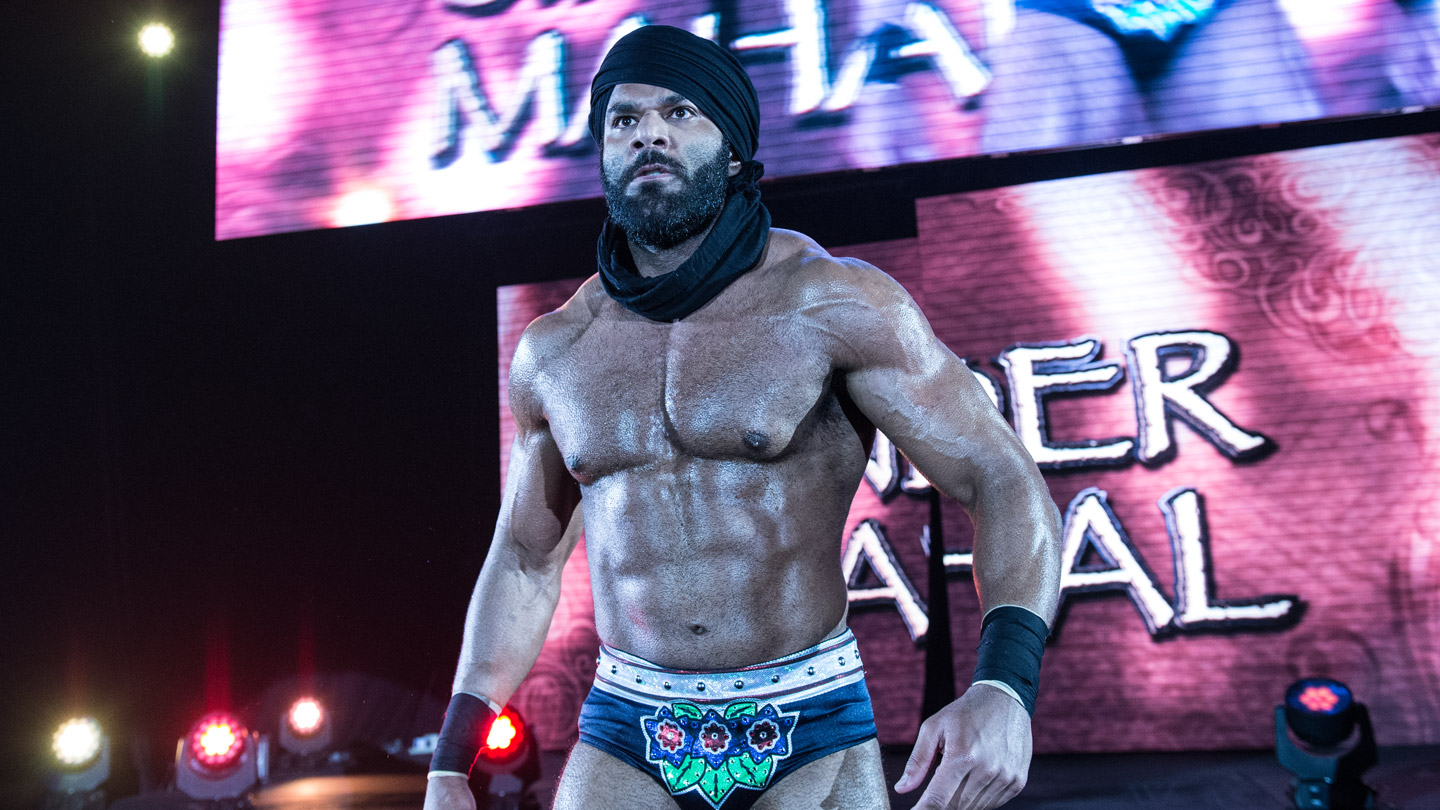Until Adam Copeland walked into the dressing room an hour or so before the 2021 Royal Rumble, no one knew the return of Edge was in the works. Maybe it’s the “re-return” of Edge, but we’ll get to that. Suffice it to say, a development like that for a PPV is usually, usually, subject to hype, not secrecy. Suffice it to say, if it’s a surprise turn for the crowd, the principals are in on it. But we live, as they say in the famous curse, in interesting times, and there wasn’t anyone in the stands — so if someone had to be caught unawares, that left those whose numbers would be called.
Even a couple of weeks after the 2021 Royal Rumble; even after he became the third wrestler in the 34-year history of the event to be both the first and last man in the ring; even with his feature slot at WrestleMania 37 booked, Edge was taking special satisfaction in that moment unseen: just walking through the dressing-room door and grabbing a stall. “The talent in the Rumble didn’t know until I walked in,” he says. “That’s when everybody went, ‘Woah, this is happening.’ I sat down with Damian Priest on one side, Matt Riddle on the other, and we just start shooting the breeze and talking. Then here comes Ricochet and then here comes The New Day, and now I’m thinking how much I missed this, how I missed this discourse. That’s when we now become peers again.”
And that’s when Copeland, age 47, the most famous son of Orangeville, Ont., once again became Edge, among the most decorated wrestlers in the history of the game. As a soloist his CV ranks among the greats: seven-time World Heavyweight Champion; four-time WWE Champion; and five-time Intercontinental Champion. Put all that aside and he’d still have a WWE Hall of Fame career based solely on his record 12 tag-team championships. “Peers” might seem to flatter the others in the room donning their tights, but “peers” aren’t necessarily “equals in accomplishment.” Neither should “peers” be read as “contemporaries” — most in the room were in grade school when Edge made his Rumble debut 21 years earlier. To put it into historical context, back at the 2000 Rumble, Edge was the 13th man in the ring, two slots ahead of Bob Backlund, whose first run as heavyweight champion dated back to 1978.
For Edge, though, the transition from historical figure to peer took as long as the locker-room door shutting behind him. “So, now I’m getting back in the ring with them,” he says. “I’m not just this uncle who is saying, ‘Hey, if you need any advice, shoot me a text or give me a call.’ That’s what I’m loving about coming back. Big E looked at me from his stall and goes, ‘We’ve never had this before.’ As crazy as that sounds, as many years as we’ve known each other, we’ve never shared a locker room before.”
The absence of fans and the fact it took place in a venue other than an arena or stadium lent a surreal feel to the 2021 Royal Rumble. In a way, hearing the sound of the bumps and the banter in the ring evoked the days when black-and-white TV tapings were shot in grotty studios — yup, that would be back when Bob Backlund was breaking into the game. Ultimately, though, the only thing more surreal than Edge winning the Royal Rumble was him being in the ring at all.

When fans vote in online polls ranking the best entrance music in the business, Edge’s play-in, “Metalingus” by Alter Bridge, usually lands near the top — if not outright looking down on all the others. First come the whispered words (“You think you know me”) and then a grunge Wall of Sound. At that point, Edge always bounced out into the spotlight, drinking in the whole moment, feeding off the volume, enjoying the spectacle from its centre. After a couple of verses, he’d stand, feet spread wide, bowed at the waist and then shoot his arms straight up, reaching for the lights, his head tilted back as the pyro framed him in silhouette. If you took it in sum, the music and the entrance itself, no one arrived better than Edge.
It’s not clear that fans listened too closely to the lyrics, which on the page might just seem like Soundgarden-variety gloom.
On this day I see clearly everything has come to life
A bitter place and a broken dream
And we’ll leave it all, leave it all behind
Alter Bridge frontman Mark Tremonti once said the theme of the lyrics was “fighting through adversity and conquering something in your life.” The song draws a hard-won, angst-drenched perspective. As it turned out, “Metalingus” would prove predictive in an awful way, as Edge at the top of his game had to leave it all behind.
Wrestling is the realm of “the false finish,” the very foundation of heightening tension. It’s there every show, every match. Think of the quick two-count before the last-second rollout. A dead-to-the-world extension of the leg for a foot on the bottom rope. Interference, a crashing of the ring. At the micro level, it’s completely ingrained. The comeback is baked into the cake. It’s over … no, wait, it ain’t over.
But there are endings and then there are endings, the latter being the greater inevitabilities. There will be for all one last time climbing through the ropes, one last ring of the bell, one last stirring victory, one last crushing loss. A few get a farewell tour — Ric Flair’s headlined shows. For most, though, it’s anything but grand. Indignities mount in sequence: past your peak; over the hill; in decline; has-been. Neither the celebrated exit nor the fade away framed the narrative of Edge’s retirement in the spring of 2011, though. There was no storyline, no design, only a seemingly non-negotiable finality.
To recap: Alberto Del Rio won the 2011 Royal Rumble and challenged Edge for the World Heavyweight Championship at WrestleMania. Hostilities mounted in the run-up, but Edge successfully defended his belt and seemed destined to do so many more times down the line. Just eight days later, however, he climbed into the ring and announced his retirement. “Trust me,” he said, as the crowd fell mournfully silent. “It’s not my choice. The doctors have told me that I’ve got no choice. And thankfully they found out because I’m not going to end up in a wheelchair now.” When those in attendance finally were able to process the moment — the talk of his spinal injuries and the prospect of paralysis and the emotional wavering in his voice — a chant went up: “Thank you, Edge.”
And across the 10 minutes that he stood in the ring that night, the wrestler known as Edge gave way to Adam Copeland, who as a kid had sat just rows from the ring for WrestleMania at the SkyDome, one of thousands there who dreamed of climbing through the ropes or going over the top one on the biggest stage. This was as if he were waking up from that dream. There was disappointment, yes, but neither bitterness nor regret. “I’m like you,” he said to the crowd. “I’m still a fan of the WWE.” He talked about the seeming impossibility of a fan becoming a pro wrestler, one who’d headline a WrestleMania with The Undertaker. There was, however, nothing seeming about the impossibility of a return. The belt draped over Copeland’s shoulder as he made that speech was one that he could never again defend.
When the diagnosis and prognosis were laid out, it just sounded final in absolute terms. No convalescence, no rehab, not for cervical spinal stenosis, not after surgeons fused vertebrae in his neck, inserting three steel plates for support. One bad bump, one sideways moment, and there’d be nothing a surgeon could do. It was just cold, hard, accepted, immutable fact, as clear to Copeland as a wheelchair. Or worse.
That Edge got back in the ring at all, never mind to WrestleMania this month, is a small miracle. Don’t read anything like desperation or recklessness into it. Edge’s walking away from wrestling in 2011 was a finish he never imagined was false.
Look around the company and you’ll find wrestlers who are second- and third-generation in the ring (Edge’s long-time blood rival, Randy Orton, is a glowing example). You’ll find others who first made their names in other sports (another Edge foil, Kurt Angle, landed in WWE with an Olympic gold around his neck). Copeland didn’t enjoy anything like these advantages and faced seemingly insurmountable hardships.
The odds were stacked against young Adam shortly after conception. “My mom, Judy Copeland, was born January 2, 1953,” he wrote in his autobiography, Adam Copeland on Edge. “She left home at the age of 17. Eventually she got married and pregnant with yours truly. Before I was born this guy took off. Not exactly a class act.”
Judy worked two jobs — secretary by day, waitress by night — to (mostly) make ends meet, but if it came down to the rent or feeding her growing boy, the latter prevailed. Other family in Orangeville were around for love and support but still his account of living in basement apartments and going to school with kids who had much more going for them is heartbreaking stuff.
Copeland has never met his father and always maintained he wasn’t much bothered by what would be a hole in another kid’s life. His uncle Gary was only nine years older than him, but was, in turns, like both the sibling and the father Adam never had. To say that he worshipped Gary would not overstate the case. Then came what turned out to be a deep hole: Gary’s death in an automobile accident at 17. Looking back, Copeland points to Gary’s death as the moment when wrestling took hold of him. As he writes in his autobiography: “I floated around for a long time until one day my TV screen was filled by a platinum blond, yellow-and-red clad behemoth with a definite fire burning in his eyes. He was telling me to drink my milk, say my prayers and take my vitamins.” It’s a testament to the power of Hulk Hogan’s image that he got Copeland through a very tough time. Likewise it’s a testament to the impressionability of the mind of a young, wounded kid.
Copeland’s book, penned before he turned 30, is of a piece with his origin story — others fight for a chance to get into the game, but he wrote his way through the gym door. Back in the spring of 1992, Sully’s Gym in Toronto’s West End ran a contest — entrants had to submit an essay expounding on their desire to become professional wrestlers. Copeland, age 18, won the contest and with it the prize: a place in the wrestling academy run by veterans Ron Hutchison and Sweet Daddy Siki. Copeland didn’t arrive as a fully formed Edge but all the ingredients were in place. “He looked pretty much the same as he does now: tall, skinny kid with long blonde hair,” Hutchison says. “I thought, ‘The girls are going to love this guy.’ To me, he had a rock-star look. He looked like somebody that was probably worth investing time in.”
Starting out, Copeland rode buses to cards in small towns and wrestled for pocket change. He drove a forklift in a factory and punched the clock at other dead-end jobs to put food on the table. He enrolled in the broadcast course at Humber College, what passed for a safety net if wrestling didn’t work out. A savings account existed only in theory. Life was threadbare as a kid and seemingly even more so when making his bones.
He made his debut in 1996, in what was then the WWF. He got a last-minute call to open a show at Copps Coliseum in Hamilton, Ont., with a match against Bob Holly — if you were to arrive 10 minutes late you would have missed it, and even if you were there you might have forgotten it. Coming in as a late substitute earned him some more work with the company (at a princely $210 a week for what amounted to an internship). Although a contract didn’t materialize immediately, at the very least he was on the radar.
His wrestling life to that point was glamour-free and living was, at times, literally a by-the-seat-of-his-tights proposition. Yet, when he talks about his wrestling apprenticeship now, true affection comes through. One line from his retirement speech in 2011 captured his memories of his early years: After running through a litany of unfortunate events and indignities, he said, “If you asked me if I’d do it all over again … in a heartbeat.”

Looking at Edge in his mid-20s, you probably wouldn’t have projected him to be a killer singles performer, never mind a WrestleMania headliner. On the plus side: He was technically well-schooled, coming out of years with Hutchison’s gym and hard time logged in the Hart House’s Dungeon in Calgary; he was tall and showed up fit; and he had looks and locks. He wasn’t, however, hyper-athletic. He wasn’t a gymnast in the ring and he wasn’t going to win pose-downs. His finishing move, the Spear, was a flying tackle — easy to imagine rattling ribs or collapsing lungs, but not likely to draw scores of 10s from the judges. In short, there wasn’t anything obvious marking him as elite.
Edge had early success with Christian as a tag team, and you could be forgiven if you thought that would be as good as it got for the two of them. That’s not to knock that path — tag-team championships have honour and esteem in their own right, and they’re a well-established ticket into the WWE Hall of Fame. Still, it falls short of the company’s pantheon — the Hall’s unofficial platinum club, of which Edge is doubtless now a member. And it’s a reasonable question: How did a guy who was one of Gangrel’s henchmen in The Brood ever wind up as a headliner at WrestleMania? How did a bit player (not to mention a guy who, as a shtick, played a kazoo) emerge from the pack and wind up as a generation-defining talent?
You can break down the dozens of storylines, the twists and turns, to find out how Edge ascended. You can do a deep dive on the evolution of the entertainment, the wants and expectations of fans, to figure out how he became a talent of his time. The easier route, though, is to put it down to sheer force of personality. You can make a case that others were better, but you can’t point to a wrestler who understood and appreciated his role better than Edge.
The best proof of Edge getting it can be found behind the scenes in the run-up to WrestleMania 24 in 2008. He was defending his World Heavyweight Championship against the Undertaker, who was at that point 15–0 at the WWE’s signature event. The Streak had already evolved as the storyline above all others on the big stage. Edge was also undefeated in his run of WrestleMania matches dating back to 2000, and creatives at the company’s headquarters were giving serious thought to breaking the Deadman’s streak. It didn’t come to pass, in no small part because Edge pushed back. Some would look on the opportunity to be the first to defeat the Undertaker at WrestleMania as an anointment as the Next Big Thing. Some would already be calculating the financial windfall. But per Michelle McCool, the Undertaker’s wife, Edge shut the idea down. His reasoning: Such a victory wouldn’t raise his stock and could devalue WrestleMania’s greatest asset, The Streak. As such decisions go, it’s far easier to see its wisdom in retrospect than in the run-up to the event.

Which brings us to the decision to come back to the WWE after nine long years. It wasn’t that Adam Copeland wandered off into the wilderness. Around the time of Edge’s retirement, Smackdown had landed on the Syfy Network in the U.S. The partners were looking for a crossover — not integrating the storylines from the WWE with Syfy’s staple dramatic series, but rather identifying talent and famous names who could grow audiences and build the brands. “The WWE came to us and said, ‘We have someone for you,’” says Lloyd Segan, who produced the Syfy series Haven. “We met and I was impressed, but when I saw the video [of his retirement announcement], I realized just how much presence and depth he had … how much emotion he could bring to a moment.” What started out as a few guest spots led to a recurring role and, in time, what Segan describes as “our fourth lead and one of the most beloved characters” in the series’ five-season run.
Haven led to other dramatic work, and Copeland established himself as a working actor with scores of credits. “Adam was great to work with,” says Jason Priestley, who first directed Copeland in Haven and then was in front of the camera with him in Private Eyes. (Editor’s note: The author of this feature wrote the book the international hit series Private Eyes is based on.) “He’s a thoughtful, humble, down-to-earth guy, always asking questions, always eager to learn. And the skills that he developed [on the mic in the WWE] really served him well as an actor. I went to acting classes…. Adam had to perform on a grand scale — in front of 80,000, not 800, and just one take. And it was on him to develop his character. That’s learning under fire.”
Copeland and his wife, Beth Phoenix, settled in Asheville, N.C., and with two young daughters, it seemed like he had fully moved on. The way it played out, however, he started physically preparing for a comeback to the WWE before he knew that a comeback was physically possible. “We had lost my mom and Beth’s dad within a two-month period, and we went through a funk without a doubt,” he says. “Then one night I was watching TV, and I ate something like 21 cookies. And I asked myself, ‘What happened?’ Then another time I walked up the stairs and I was out of breath. I’m thinking, ‘I’ve got two little girls. I’ve got to be around for them. I’ve got to be healthy for them. I’ve got to be Dad for them.’ And that was the kick in the ass to get in shape.”
The next day, Copeland was lifting and working out in the gym in his garage. And, well, since those cookies, he hasn’t stopped working out. He was giving no thoughts to a comeback, though. A return to fitness is a limp-in ante but a return to the spotlight is all-in. And still, there was the absolute you’ve-got-no-choice message that he had received in 2011.
In his years after retirement from the WWE, Copeland wasn’t completely on the sidelines physically. He had been doing his own stunts in shows like Vikings, but nothing so high risk as he’d see in 30 seconds of ring action. What prompted a re-assessment of his neck injury was a scare: a tumble he took on a mountain bike. “I was going to go faster and higher and harder than I usually do and I wiped out, going downhill and going about 20 miles an hour,” he says. “I just bit it, but I was okay. I saw a doctor and asked him about my neck. I hadn’t had a checkup since I’d had my second fusion in 2012. He did the assessment and said, ‘Your neck looks as healthy as it’s going to, with everything that’s happened to it.’”
That prompted Copeland to seek other opinions. In the round of appointments, the most important was with Dr. James Andrews, the Alabama-based surgeon who’s the first choice of injured athletes in every sport. “I went to his clinic [in 2019] and they did the imaging and examination,” he says. “And they went, ‘Clear.’ My first reaction was, ‘What?’”
It started to sink in. This wasn’t a red light giving way to a flashing green. It was a proceed-with-caution. “I was told that I have to be careful and I can’t keep the type of schedule I used to do,” Copeland says. “I didn’t even know how to process it. I had a six-hour drive back to Asheville to try to wrap my mind around it. So I bought a box of donuts and drove home and called Beth and called Christian, and basically anybody who was super close to me.”
Cleared, Copeland weighed what this unexpected comeback might look like. He wasn’t sure what he wanted, but he knew what he didn’t want: to simply pick up where he left off. “I didn’t come back to do the greatest hits,” he says. “I came back to tell better stories and have better matches.”
Which is to say, if there were limits imposed by age and injury, he had to lean in on the performative aspects, lessons he learned on movie and TV sets. “I would hope you’re seeing what I took away from it,” he says. “I’m trying to make [my promos] sound real, trying to make them sound conversational. Even while you’re portraying this larger-than-life character, that doesn’t mean you have to yell and scream and be this huge bombastic thing. You can pull it back. I think our audience now wants that type of realism and wants those, those kinds of layers and nuances to a character. Pulling things back, that’s what I had to learn when I first started acting. Less is more.”
Copeland sounds very much like an actor when he breaks down the character of Edge and the physical subtleties (and not-so-subtleties) that his role in the WWE demands. To make the transition to acting in TV and movies, he had to be aware that the camera was all-powerful and absolutely unforgiving. “My eyes were always the conduit to what Edge was doing,” he says. “[But] when I started on one shoot, the director had me watch one of my scenes and I thought, ‘God, I look like a maniac.’ Got it.”
Copeland’s ability to make the less-is-more approach work for him is, he suggests, oddly well-timed for the pandemic. Effectively, in the absence of any crowd whatsoever, the 2021 Royal Rumble was a studio shoot. On that stage, more would feel forced, less felt genuine.
Of course, it’s not all Inside the Actors Studio. It’s still inside the ring, still inside the WWE. And ever the avowed fan, Copeland doesn’t want it to be all about Edge. His goals only start with telling better stories and making better matches. They extend to making the talent in the company better, including those he’s been introduced to since his return to the ring. . He was coming back not just to entertain fans but to provide teachable lessons for the WWE’s next generation. “I’ve been doing this for 29 years,” he says. “I’ve experienced almost everything that you can encounter within our industry, and it would be really satisfying if I can impart any little bit of what I’ve learned to a new talent.”
Copeland didn’t want Edge to become an occasional player, brought out of the archives for big events. For a template for his comeback, the hardcore hockey fan looked to a former star with his home team. “I remember when Gary Roberts came out of retirement after what seemed like a career-ending neck injury,” Copeland says. “I remember hearing about his fitness regimen, and just thinking at the time, like, ‘Wow, good for him,’ because that’s not supposed to happen. When [Roberts] came back, he was better. When you think something’s taken away from you, when you can get it back, you realize, ‘Wait, I can be smarter about this.’ I’m not relying on some of the things that maybe I relied on before, because now I can’t physically pull that off, but if I’m smart and I invest in the character and hit some different notes … digging into layers underneath now, I’m working smarter and making everyone around me better, like Roberts did.”
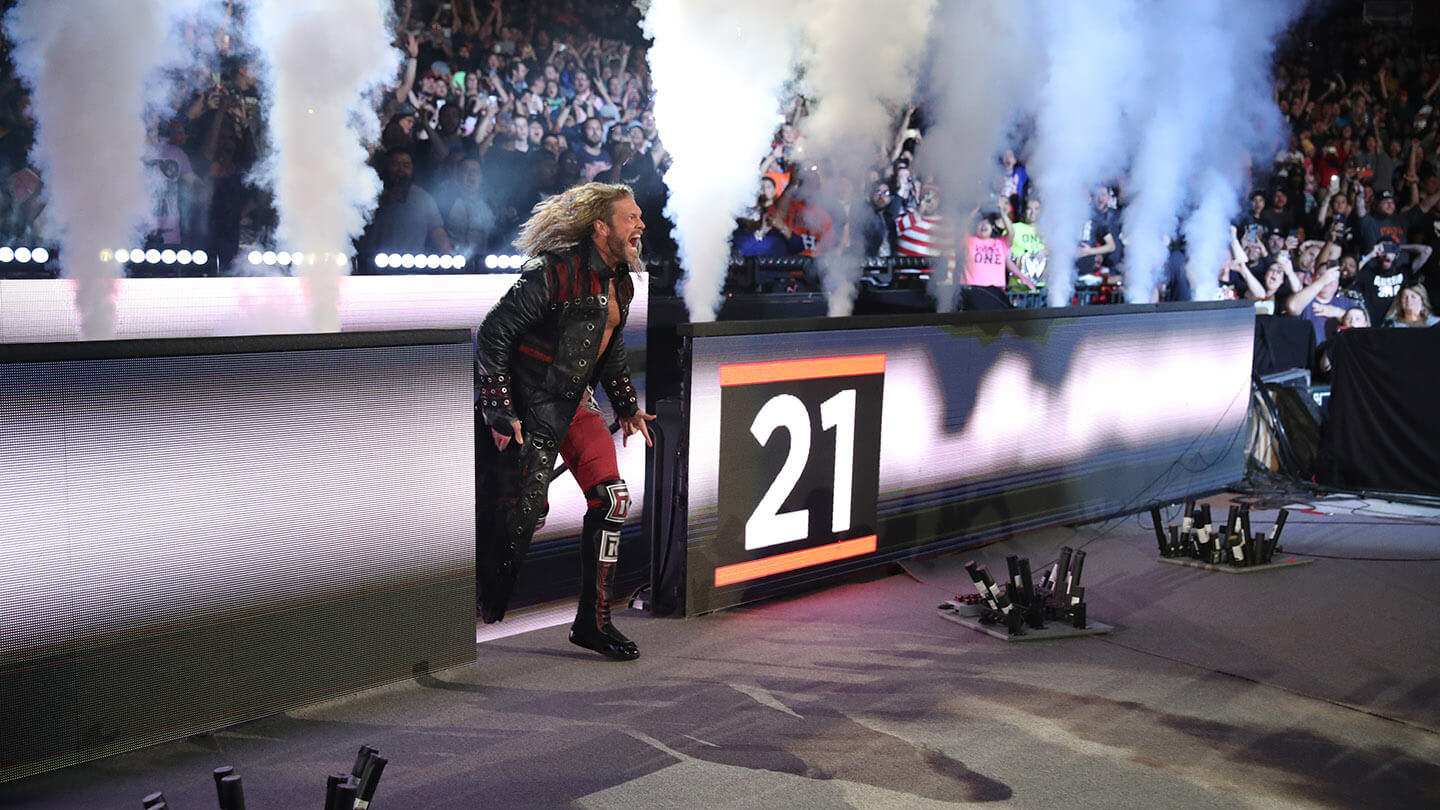
Edge’s surprise comeback was originally targeted for 2020, but like a lot of things that year it hit a considerable speed bump.
It started promisingly enough at the 2020 Royal Rumble — 42,715 fans at Minute Maid Park in Houston, and not one of them saw Edge’s arrival coming. It was anything but a celebrity cameo, as sometimes happens at the over-the-top-rope melee. Drawing the 21st slot, Edge eliminated A.J. Styles, Luke Gallows and Orton, making it to the final three with eventual winner Drew McIntyre and runner-up Roman Reigns. Aesthetically, it ranked as a success and promised big things in shows ahead. Shortly thereafter, though, a 46-year-old tricep didn’t cooperate, and at a pretty inconvenient time: during a match against Orton at the Backlash PPV. “It tore off the bone and I knew it was bad,” he says. “I’ve torn enough stuff that I know. I had a nauseous feeling, cold sweats. My friend who’s a surgeon operated on it and he told me, ‘We put four anchors in your elbow, so it’s not going anywhere, but it’s not going to feel great for awhile.’”
It looked like the comeback would be derailed. Maybe in other games you can get away with one arm — tennis, say — but two healthy wings are pretty essential in the ring. And then throw in the pandemic, a whole other level of complication. Copeland could have pulled the chute at that point, but, after all he had been through, his fusion surgeries, a torn Achilles and umpteen other injuries over the years, he wasn’t going to get discouraged. “Fact is, I didn’t miss a day at the gym,” he says. “I could still do my cardio. I could still lift weights with my good side, so I never stopped. I just had to reconfigure what I did. The elbow was like a cavity. A year later, I still know it’s there. I’ve found with any surgery, it usually takes about a year to get to where you can say, ‘Okay, the pain is gone. The residual pain is gone.’”
No doubt adrenaline in the heat of competition numbed any residual pain over the hour Edge was in the ring at the 2021 Royal Rumble. Maybe that pain will be fully gone by the time he is played into the ring with “Metalingus” at WrestleMania to face Roman Reigns, who’ll be defending the Universal Championship. Edge won’t be the only challenger in the ring — Daniel Bryan will also be in the mix in a three-man match, unique at the top of the card on the WWE’s big night. What will go down from there, where the story of Edge will go, you can only guess. Think less about outcome than effect, and there are some safe bets: It won’t be all about him, even if he comes away with the title. He put the interest of the brand and the event first when the Undertaker’s Streak was on the line; it’s no great leap to envision the match against Reigns as a catalyst rather than a final destination.
It’s a cliché to say you’re “just happy to be here,” but that’s the point that Edge has reached at age 47, in his surprising second act. “Being a dad has given me more appreciation for life,” he says. “Losing my mom, losing John — Beth’s dad. All of those things made me realize, you just have to live in the moment and appreciate everything you really do. Because when you stop doing that, then you become that jaded malcontent. I don’t want to do that. And that can be easy to do in the grind. I’m just soaking all of this up. I get in that locker room and I have young guys come up to me asking questions. It’s so much fun. It’s invigorating. I’m in heaven.”


